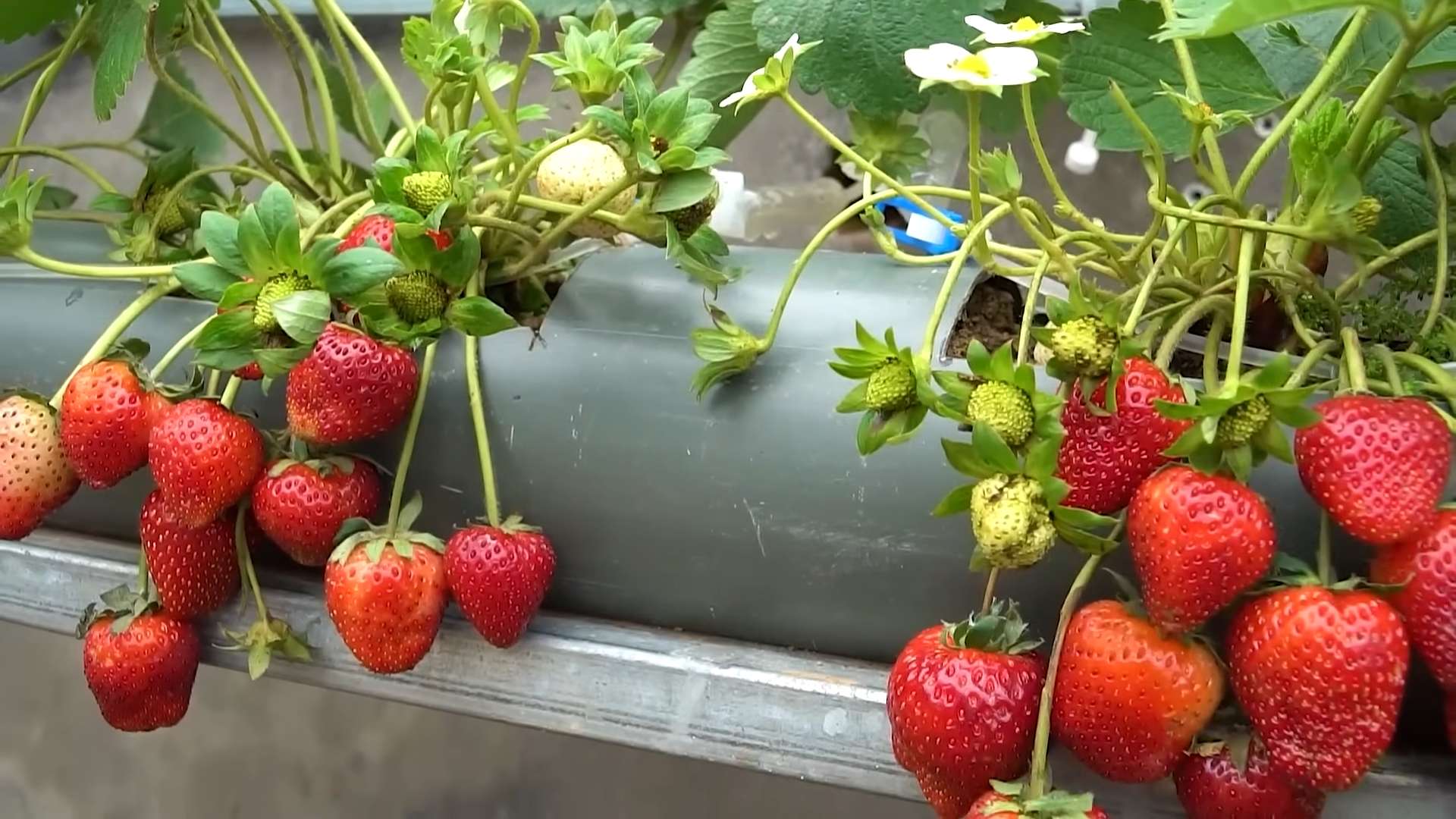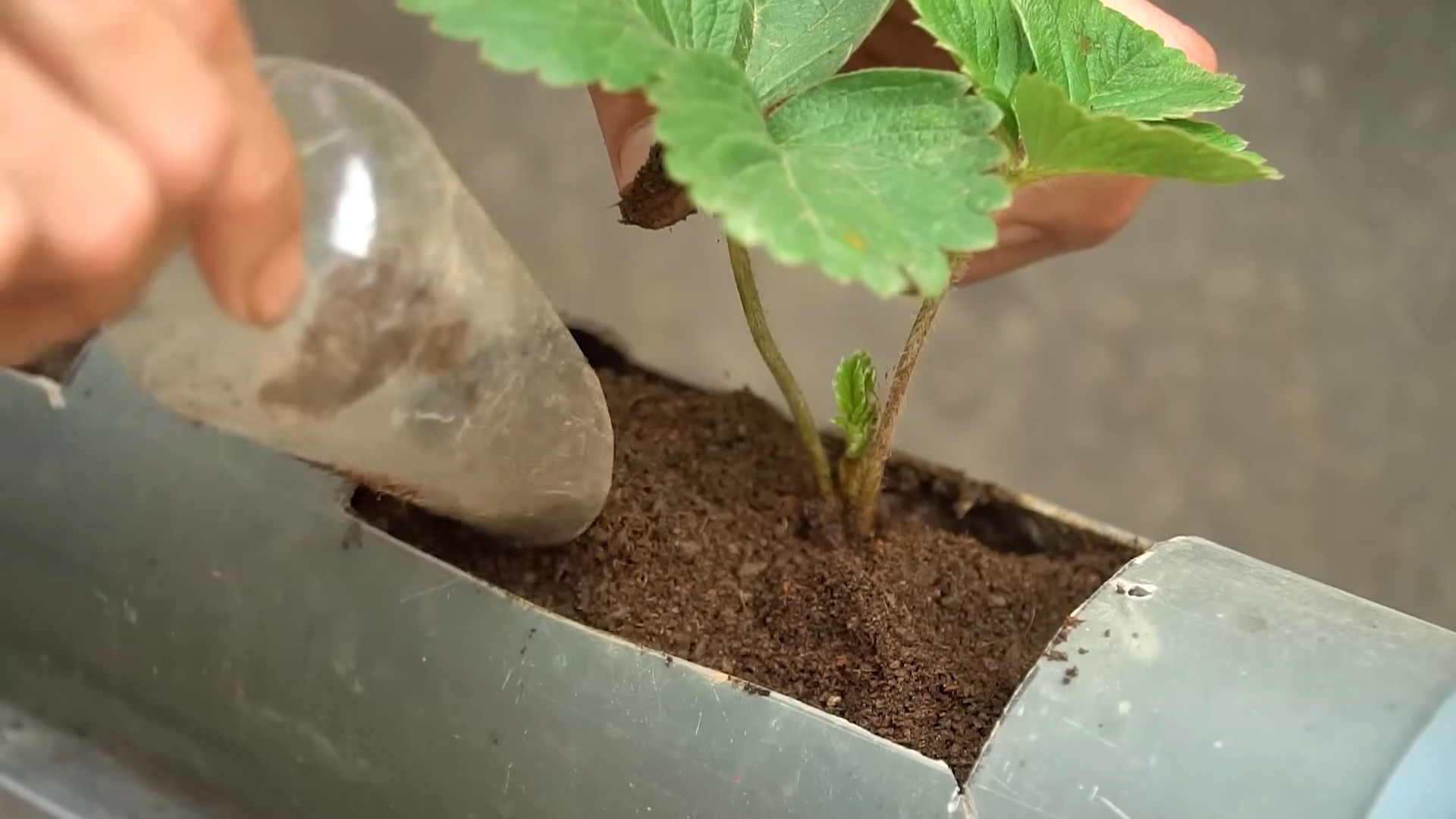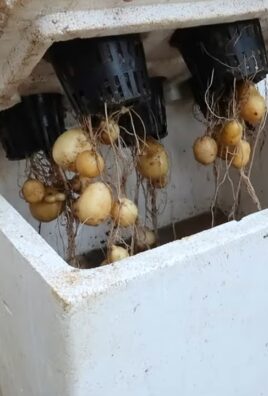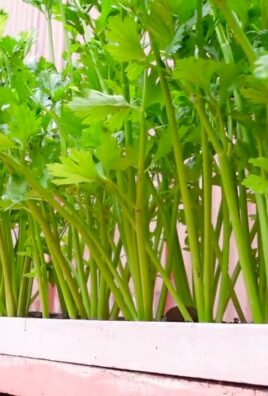Grow Strawberries at Home? Absolutely! Imagine stepping into your backyard and plucking a sun-ripened, juicy strawberry, bursting with flavor that no store-bought berry can match. That’s the magic of home gardening, and it’s easier than you think! For centuries, cultivating our own food has been a deeply satisfying practice, connecting us to nature and providing fresh, healthy produce. From ancient Roman gardens to the victory gardens of World War II, growing your own food has always been a symbol of self-sufficiency and resilience.
But let’s be honest, not everyone has acres of land or a green thumb passed down through generations. That’s where these DIY tricks and hacks come in! I’m here to show you how to grow strawberries at home, even if you have limited space or consider yourself a gardening novice. We’ll explore simple, effective methods that will transform your balcony, patio, or even a sunny windowsill into a thriving strawberry patch.
Why strawberries, you ask? Well, besides being incredibly delicious, they’re packed with vitamins and antioxidants. Plus, knowing exactly where your food comes from and how it’s grown gives you peace of mind. So, ditch the expensive supermarket berries and get ready to embark on a fun and rewarding gardening adventure. Let’s get started!

Grow Your Own Delicious Strawberries: A Beginner’s Guide
Hey there, fellow gardening enthusiasts! Ever dreamt of plucking juicy, sun-ripened strawberries straight from your own backyard? Well, dream no more! Growing strawberries at home is surprisingly easy and incredibly rewarding. I’m going to walk you through everything you need to know, from choosing the right variety to harvesting your sweet bounty. Let’s get started!
Choosing the Right Strawberry Variety
Before you even think about planting, you need to decide which type of strawberry is right for you. There are three main types:
* June-Bearing: These are the classic strawberries that produce one large crop in the spring, usually around June (hence the name!). They’re great if you want to make a big batch of jam or freeze a lot of berries at once.
* Everbearing: Don’t let the name fool you; everbearing strawberries don’t produce fruit continuously. Instead, they produce two or three crops per year – one in the spring, one in the late summer or early fall, and sometimes a smaller crop in between.
* Day-Neutral: These are the most consistent producers, yielding fruit throughout the growing season as long as the temperature is between 35°F and 85°F. They’re perfect for a steady supply of fresh strawberries.
Consider your climate, the amount of space you have, and how you plan to use your strawberries when making your choice. I personally love day-neutral varieties because I enjoy having fresh strawberries all summer long!
Preparing Your Strawberry Patch
Strawberries need a sunny spot and well-drained soil to thrive. Here’s how to get your garden ready:
* Sunlight: Strawberries need at least 6-8 hours of direct sunlight per day. Choose a location that gets plenty of sun.
* Soil: Strawberries prefer slightly acidic soil with a pH between 5.5 and 6.8. If you’re not sure about your soil’s pH, you can get a soil testing kit at most garden centers.
* Drainage: Good drainage is crucial. Strawberries hate having wet feet! If your soil is heavy clay, amend it with compost, peat moss, or other organic matter to improve drainage.
* Weed Removal: Clear the area of all weeds and grass. Strawberries don’t compete well with weeds, so it’s important to start with a clean slate.
Planting Your Strawberry Plants
Now for the fun part – planting! You can buy strawberry plants as bare-root plants or as potted plants. I’ve had success with both, but bare-root plants are usually more economical.
Step-by-Step Planting Instructions:
1. Soak Bare-Root Plants: If you’re using bare-root plants, soak the roots in water for about an hour before planting. This will help rehydrate them.
2. Dig the Holes: Dig holes that are large enough to accommodate the roots of your strawberry plants. Space the plants about 12-18 inches apart in rows that are 2-3 feet apart.
3. Planting Depth: This is important! Make sure the crown of the plant (where the roots meet the stem) is level with the soil surface. Planting too deep can cause the crown to rot, while planting too shallow can dry out the roots.
4. Spread the Roots: Gently spread the roots out in the hole before covering them with soil.
5. Water Thoroughly: After planting, water the plants thoroughly to settle the soil and help them establish.
Caring for Your Strawberry Plants
Once your strawberry plants are in the ground, they’ll need some TLC to thrive.
* Watering: Water regularly, especially during dry spells. Strawberries need about 1 inch of water per week. Water at the base of the plants to avoid wetting the foliage, which can lead to fungal diseases.
* Fertilizing: Fertilize your strawberry plants in the spring with a balanced fertilizer. Follow the instructions on the fertilizer package. Avoid over-fertilizing, as this can lead to excessive foliage growth and fewer berries.
* Weed Control: Keep the area around your strawberry plants free of weeds. You can use mulch to help suppress weeds and retain moisture.
* Pest and Disease Control: Keep an eye out for pests and diseases. Common strawberry pests include slugs, snails, and aphids. Common diseases include gray mold and leaf spot. Treat any problems promptly with appropriate organic or chemical controls. I prefer using organic methods whenever possible.
* Removing Runners: June-bearing strawberries produce runners, which are long stems that grow out from the main plant and develop new plantlets. If you want to maximize your berry production, remove the runners as they appear. This will encourage the plant to put its energy into producing fruit instead of new plants. Everbearing and day-neutral varieties also produce runners, but not as prolifically. You can choose to remove them or let them grow to create a larger strawberry patch.
Protecting Your Strawberries
Birds and other critters love strawberries just as much as we do! Here are some ways to protect your precious berries:
* Netting: Cover your strawberry plants with netting to keep birds away. Make sure the netting is securely anchored to the ground so that birds can’t get underneath it.
* Row Covers: Row covers can also protect your strawberries from birds, insects, and frost.
* Companion Planting: Some gardeners believe that planting certain herbs and flowers near strawberries can help deter pests. For example, marigolds are said to repel nematodes, and borage is said to attract beneficial insects.
Harvesting Your Strawberries
The moment you’ve been waiting for! Strawberries are usually ready to harvest about 30 days after they bloom.
* Ripeness: Look for berries that are fully red and slightly soft to the touch.
* Harvesting Technique: Gently twist or cut the stem just above the berry. Avoid pulling the berry off the plant, as this can damage the plant.
* Timing: Harvest your strawberries in the morning, after the dew has dried.
* Storage: Store your strawberries in the refrigerator. They’re best eaten fresh, but they can also be frozen or made into jam.
Growing Strawberries in Containers
Don’t have a garden? No problem! You can easily grow strawberries in containers.
* Container Size: Choose a container that is at least 12 inches in diameter and 8 inches deep.
* Potting Mix: Use a high-quality potting mix that drains well.
* Planting: Plant your strawberry plants in the container, following the same instructions as for planting in the ground.
* Location: Place the container in a sunny location.
* Watering and Fertilizing: Water and fertilize your container-grown strawberries regularly. They may need more frequent watering than strawberries grown in the ground, as containers tend to dry out more quickly.
* Overwintering: In cold climates, you may need to protect your container-grown strawberries from freezing temperatures. You can move the containers to a sheltered location, such as a garage or shed, or wrap them in burlap.
Troubleshooting Common Strawberry Problems
Even with the best care, you may encounter some problems when growing strawberries. Here are some common issues and how to address them:
* Small Berries: Small berries can be caused by a variety of factors, including poor pollination, lack of water, and nutrient deficiencies. Make sure your plants are getting enough sun, water, and fertilizer. You can also try hand-pollinating the flowers with a small brush.
* Rotting Berries: Rotting berries are often caused by fungal diseases, such as gray mold. To prevent this, avoid wetting the foliage when watering and provide good air circulation around the plants. Remove any infected berries promptly.
* Pest Infestations: Keep an eye out for pests, such as slugs, snails, and aphids. Treat any infestations promptly with appropriate organic or chemical controls.
* Lack of Fruit: If your strawberry plants are not producing fruit, it could be due to a lack of sunlight, poor pollination, or nutrient deficiencies. Make sure your plants are getting enough sun, water, and fertilizer. You can also try hand-pollinating the flowers.
Propagating Strawberries
Want to expand your strawberry patch without buying more plants? You can easily propagate strawberries from runners.
1. Choose a Runner: Select a healthy runner with a well-developed plantlet.
2. Rooting the Plantlet: Place the plantlet in a small pot filled with potting mix. You can secure the runner to the pot with a paperclip or hairpin.
3. Watering: Water the plantlet regularly to keep the soil moist.
4. Separating the Plantlet: Once the plantlet has developed roots, you can cut the runner from the mother plant.
5. Transplanting: Transplant the new strawberry plant to its permanent

Conclusion
So, there you have it! Growing strawberries at home, especially using this simple DIY trick, is more than just a gardening project; it’s an investment in fresh, flavorful fruit, a sustainable lifestyle, and a rewarding hobby. Forget those bland, store-bought berries that lack the vibrant taste of sunshine and homegrown goodness. This method offers a cost-effective and space-saving solution, perfect for anyone, regardless of their gardening experience.
Why is this a must-try? Because it simplifies the process, maximizes your yield, and puts you in control of what goes into your food. You’ll know exactly where your strawberries come from and how they were grown, free from harmful pesticides and chemicals. Imagine the satisfaction of picking your own juicy, red strawberries right from your backyard (or balcony!) and using them in your favorite recipes.
But the fun doesn’t stop there! Feel free to experiment with different strawberry varieties to discover your personal favorite. Try alpine strawberries for a delicate, woodland flavor, or everbearing varieties for a continuous harvest throughout the season. You can also adapt this DIY trick to suit your specific space and needs. Use different containers, like hanging baskets or repurposed materials, to create a unique and visually appealing strawberry garden.
Consider companion planting to further enhance your strawberry patch. Marigolds can deter pests, while basil can improve the flavor of your berries. The possibilities are endless!
We’re confident that once you try this DIY trick for growing strawberries at home, you’ll be amazed by the results. It’s a simple, effective, and incredibly rewarding way to enjoy fresh, delicious strawberries all season long. Don’t just take our word for it – give it a try and experience the joy of homegrown strawberries for yourself!
We encourage you to embark on this strawberry-growing adventure. Share your experiences with us! Let us know what worked well for you, what challenges you faced, and any variations you tried. Your feedback will not only help us improve this guide but also inspire other aspiring strawberry growers. Post pictures of your thriving strawberry plants and delicious harvests on social media using #HomegrownStrawberries and #DIYGardening. Let’s create a community of passionate strawberry enthusiasts!
Frequently Asked Questions (FAQ)
What is the best time of year to start growing strawberries using this DIY method?
The ideal time to start growing strawberries depends on your climate and the type of strawberry you’re planting. Generally, early spring or late fall are the best times to plant bare-root strawberries. This allows the plants to establish themselves before the extreme heat of summer or the cold of winter. If you’re starting with established plants in containers, you can plant them almost any time of year, as long as you protect them from frost. For June-bearing varieties, planting in early spring will give you a harvest the following year. Everbearing and day-neutral varieties planted in spring may produce a smaller crop in their first year but will provide a more substantial harvest in subsequent years. Always check the specific recommendations for the strawberry variety you choose.
What kind of soil is best for growing strawberries in containers?
Strawberries thrive in well-draining, slightly acidic soil with a pH between 5.5 and 6.5. A good potting mix specifically formulated for fruits and vegetables is an excellent choice. You can also create your own mix by combining equal parts of potting soil, compost, and perlite or vermiculite. The compost provides essential nutrients, while the perlite or vermiculite improves drainage and aeration. Avoid using garden soil in containers, as it can become compacted and doesn’t drain well, which can lead to root rot. Ensure your container has drainage holes to prevent waterlogging.
How often should I water my strawberry plants?
Watering frequency depends on several factors, including the weather, the type of container you’re using, and the stage of growth of your plants. Generally, you should water your strawberry plants whenever the top inch of soil feels dry to the touch. During hot, dry weather, you may need to water them daily. Avoid overwatering, as this can lead to root rot. Water deeply, allowing the water to drain out of the bottom of the container. A good rule of thumb is to water in the morning so the foliage has time to dry before nightfall, which can help prevent fungal diseases.
What kind of fertilizer should I use for my strawberry plants?
Strawberries benefit from regular fertilization, especially during their growing season. Use a balanced fertilizer with an NPK ratio of 10-10-10 or 12-12-12. You can also use a fertilizer specifically formulated for berries. Apply the fertilizer according to the package directions, usually every 4-6 weeks. Avoid over-fertilizing, as this can burn the roots and damage the plants. Organic options like compost tea or fish emulsion are also excellent choices for feeding your strawberry plants. During the dormant season (winter), reduce or eliminate fertilization.
How do I protect my strawberry plants from pests and diseases?
Strawberries are susceptible to various pests and diseases, but there are several steps you can take to protect your plants. Regularly inspect your plants for signs of pests, such as aphids, spider mites, or slugs. Handpick pests whenever possible. You can also use insecticidal soap or neem oil to control infestations. To prevent fungal diseases, ensure good air circulation around your plants and avoid overhead watering. Remove any dead or diseased leaves promptly. Consider using organic fungicides if necessary. Netting can protect your berries from birds and other animals.
How do I overwinter my strawberry plants in cold climates?
In cold climates, strawberry plants need protection during the winter to survive. After the first frost, trim back the foliage to about 2-3 inches. Mulch heavily around the plants with straw, leaves, or pine needles to insulate the roots. If you’re growing strawberries in containers, you can move them to a sheltered location, such as a garage or shed, or bury the containers in the ground. Water the plants occasionally during the winter to prevent them from drying out completely. Remove the mulch in the spring when the weather warms up.
How long does it take for strawberry plants to produce fruit?
The time it takes for strawberry plants to produce fruit depends on the variety and the planting time. June-bearing varieties typically produce a single, large crop in the spring or early summer of their second year. Everbearing and day-neutral varieties may produce a smaller crop in their first year, followed by a more substantial harvest in subsequent years. With proper care, you can expect to harvest strawberries for several years from the same plants. Be patient and provide your plants with the necessary care, and you’ll be rewarded with delicious, homegrown strawberries.




Leave a Comment